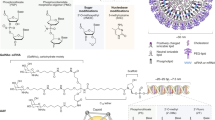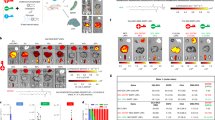Abstract
The present study was undertaken to examine whether ribozymes cleaving specifically cathepsin L (CL) mRNA are able to decrease the synthesis of CL protease in rheumatoid arthritis synovial fibroblasts (RA-SF) and thereby reduce the invasiveness into cartilage both in vitro and in the SCID mouse coimplantation model of RA. Two different ribozymes that cleave CL mRNA specifically at positions 533 (RzCL533) and 790 (RzCL790) were generated. Using retroviral gene transfer, RA-SF were transduced with the ribozyme constructs or the empty vector. To examine the effect of the ribozymes on the mRNA level, quantitative analysis for CL mRNA was performed using real-time PCR. For evaluation on the protein level, ELISA using specific anti-CL antibodies was performed. In addition, transduced RA-SF were examined in vitro in a three-dimensional destruction assay evaluating their ability to degrade extracellular matrix produced by human chondrocytes. Matrix destruction was monitored by the release of soluble glycosaminoglycans (sGAG). Using the in vivo SCID mouse coimplantation model of RA, RzCL533-transduced RA-SF and control cells were coimplanted with human cartilage for 60 days. After being killed, invasion of RA-SF into the cartilage was evaluated by using a semiquantitative score. Transduction of RA-SF with RzCL533 and RzCL790 ribozymes decreased significantly the expression of CL mRNA to 44% (range 25–62%) and 20% (range 1–43%), respectively, when compared to mock-transduced cells. The protein concentration of CL in the cell culture supernatants of transduced RA-SF was decreased from 16.0 ng/ml in the mock constructs to 4.1 and 8.2 ng/ml (mean), respectively. Using the in vitro cartilage destruction assay, the release of sGAG decreased to 46 and 60%, respectively, after 14 days when compared to mock-transduced cells. In the SCID mouse coimplantation model of RA, RzCL533-transduced RA-SF revealed a significant lower cartilage invasion when compared to mock and untransduced cells. Using retroviral gene transfer, ribozymes cleaving CL mRNA inhibit specifically the synthesis of this matrix-degrading enzyme and reduce cartilage destruction in in vitro and in vivo models. Our study therefore suggests that ribozymes targeting CL could be a novel and efficient tool to inhibit joint destruction in RA.
This is a preview of subscription content, access via your institution
Access options
Subscribe to this journal
Receive 12 print issues and online access
$259.00 per year
only $21.58 per issue
Buy this article
- Purchase on Springer Link
- Instant access to full article PDF
Prices may be subject to local taxes which are calculated during checkout





Similar content being viewed by others
References
Müller-Ladner U, Gay RE, Gay S . Molecular biology of cartilage and bone destruction. Curr Opin Rheumatol 1998; 10: 212–219.
Szekanecz Z, Koch AE . Update on synovitis. Curr Rheumatol Rep 2001; 3: 53–63.
Bresnihan B . Pathogenesis of joint damage in rheumatoid arthritis. J Rheumatol 1999; 26: 717–719.
Pap T et al. Activation of synovial fibroblasts in rheumatoid arthritis: lack of expression of the tumour suppressor PTEN at sites of invasive growth and destruction. Arthritis Res 2000; 2: 59–64.
Tak PP, Zvaifler NJ, Green DR, Firestein GS . Rheumatoid arthritis and p53: how oxidative stress might alter the course of inflammatory diseases. Immunol Today 2000; 21: 78–82.
Oppenheimer-Marks N, Lipsky PE . Adhesion molecules in rheumatoid arthritis. Springer Semin Immunopathol 1998; 20: 95–114.
Konttinen YT et al. Analysis of 16 different matrix metalloproteinases (MMP-1 to MMP-20) in the synovial membrane: different profiles in trauma and rheumatoid arthritis. Ann Rheum Dis 1999; 58: 691–697.
van der Laan WH et al. Cartilage degradation and invasion by rheumatoid synovial fibroblasts is inhibited by gene transfer of a cell surface-targeted plasmin inhibitor. Arthritis Rheum 2000; 43: 1710–1718.
Keyszer G et al. Differential expression of cathepsins B and L compared with matrix metalloproteinases and their respective inhibitors in rheumatoid arthritis and osteoarthritis: a parallel investigation by semiquantitative reverse transcriptase-polymerase chain reaction and immunohistochemistry. Arthritis Rheum 1998; 41: 1378–1387.
Pap T, Müller-Ladner U, Gay RE, Gay S . Fibroblast biology. Role of synovial fibroblasts in the pathogenesis of rheumatoid arthritis. Arthritis Res 2000; 2: 361–367.
Maciewicz RA, Wotton SF, Etherington DJ, Duance VC . Susceptibility of the cartilage collagens types II, IX and XI to degradation by the cysteine proteinases, cathepsins B and L. FEBS Lett 1990; 269: 189–193.
Nguyen Q, Mort JS, Roughley PJ . Cartilage proteoglycan aggregate is degraded more extensively by cathepsin L than by cathepsin B. Biochem J 1990; 266: 569–573.
Kane SE, Gottesman MM . The role of cathepsin L in malignant transformation. Semin Cancer Biol 1990; 1: 127–136.
Iwata Y, Mort JS, Tateishi H, Lee ER . Macrophage cathepsin L, a factor in the erosion of subchondral bone in rheumatoid arthritis. Arthritis Rheum 1997; 40: 499–509.
Trabandt A et al. Expression of the collagenolytic and Ras-induced cysteine proteinase cathepsin L and proliferation-associated oncogenes in synovial cells of MRL/I mice and patients with rheumatoid arthritis. Matrix 1990; 10: 349–361.
Keyszer GM et al. Comparative analysis of cathepsin L, cathepsin D, and collagenase messenger RNA expression in synovial tissues of patients with rheumatoid arthritis and osteoarthritis by in situ hybridization. Arthritis Rheum 1995; 38: 976–984.
Dohchin A et al. Immunostained cathepsins B and L correlate with depth of invasion and different metastatic pathways in early stage gastric carcinoma. Cancer 2000; 89: 482–487.
Strojnik T, Zidanik B, Kos J, Lah TT . Cathepsins B and L are markers for clinically invasive types of meningiomas. Neurosurgery 2001; 48: 598–605.
Strojan P et al. Prognostic significance of cysteine proteinases cathepsins B and L and their endogenous inhibitors stefins A and B in patients with squamous cell carcinoma of the head and neck. Clin Cancer Res 2000; 6: 1052–1062.
Soderstrom M et al. Cysteine proteinases in chondrosarcomas. Cysteine proteinases in chondrosarcomas. Matrix Biol 2001; 19: 717–725.
Putnam DA . Antisense strategies and therapeutic applications. Am J Health Syst Pharm 1996; 53: 151–160.
Sullivan SM . Development of ribozymes for gene therapy. J Invest Dermatol 1994; 103: 85S–89S.
Campbell TB, Sullenger BA . Alternative approaches for the application of ribozymes as gene therapies for retroviral infections. Adv Pharmacol 1995; 33: 143–178.
Müller-Ladner U et al. Synovial fibroblasts of patients with rheumatoid arthritis attach to and invade normal human cartilage when engrafted into SCID mice. Am J Pathol 1996; 149: 1607–1615.
Burstein H . Gene therapy for rheumatoid arthritis. Curr Opin Mol Ther 2001; 3: 362–374.
Evans CH et al. Clinical trial to assess the safety, feasibility, and efficacy of transferring a potentially anti-arthritic cytokine gene to human joints with rheumatoid arthritis. Hum Gene Ther 1996; 7: 1261–1280.
Gouze E et al. Gene therapy for rheumatoid arthritis. Expert Opin Biol Ther 2001; 1: 971–978.
Pap T, Gay RE, Müller-Ladner U, Gay S . Ex vivo gene transfer in the years to come. Arthritis Res 2002; 4: 10–12.
Perlman H et al. Bcl-2 expression in synovial fibroblasts is essential for maintaining mitochondrial homeostasis and cell viability. J Immunol 2000; 164: 5227–5235.
van der Laan WH et al. Cartilage degradation and invasion by rheumatoid synovial fibroblasts is inhibited by gene transfer of TIMP-1 and TIMP-3. Gene Therapy 2003; 10: 234–242.
Neumann E et al. Inhibition of cartilage destruction by double gene transfer of IL-1Ra and IL-10 involves the activin pathway. Gene Therapy 2002; 9: 1508–1519.
Kirschke H et al. Antisense RNA inhibition of cathespin L expression reduces tumorigenicity of malignant cells. Eur J Cancer 2000; 36: 787–795.
Krueger S, Kellner U, Buehling F, Roessner A . Cathepsin L antisense oligonucleotides in a human osteosarcoma cell line: effects on the invasive phenotype. Cancer Gene Ther 2001; 8: 522–528.
Kitajima I et al. Ribozyme-based gene cleavage approach to chronic arthritis associated with human T cell leukemia virus type I: induction of apoptosis in synoviocytes by ablation of HTLV-I tax protein. Arthritis Rheum 1997; 40: 2118–2127.
Macejak DG et al. Inhibition of hepatitis C virus (HCV)-RNA-dependent translation and replication of a chimeric HCV poliovirus using synthetic stabilized ribozymes. Hepatology 2000; 31: 769–776.
Macejak DG et al. Enhanced antiviral effect in cell culture of type 1 interferon and ribozymes targeting HCV RNA. J Viral Hepat 2001; 8: 400–405.
Arnett FC et al. The American Rheumatism Association 1987 revised criteria for the classification of rheumatoid arthritis. Arthritis Rheum 1988; 31: 315–324.
Gewirtz AM, Sokol DL, Ratajczak MZ . Nucleic acid therapeutics: state of the art and future prospectives. Blood 1998; 92: 712–736.
James HA, Gibson I . The therapeutic potential of ribozymes. Blood 1998; 91: 371–382.
Zuker M, Jacobson AB . Well-determined regions in RNA secondary structure predictions: analysis of small subunit ribosomal RNA. Nucleic Acids Res 1995; 23: 2791–2798.
Joseph LJ, Chang LC, Stamenkovich D, Sukhatme VP . Complete nucleotide and deduced amino acid sequences of human and murine preprocathepsin L. J Clin Invest 1998; 81: 1621–1629.
Neidhart M, Gay RE, Gay S . Anti-interleukin-1 and anti-CD44 interventions producing significant inhibition of cartilage destruction in an in vitro model of cartilage invasion by rheumatoid arthritis synovial fibroblasts. Arthritis Rheum 2000; 43: 1719–1728.
Acknowledgements
This work was supported by the Swiss National Science Foundation 3200-64142.00. Wolfgang Zacharias was supported by a Biomedical Science Grant from the Arthritis Foundation, USA.
Author information
Authors and Affiliations
Rights and permissions
About this article
Cite this article
Schedel, J., Seemayer, C., Pap, T. et al. Targeting cathepsin L (CL) by specific ribozymes decreases CL protein synthesis and cartilage destruction in rheumatoid arthritis. Gene Ther 11, 1040–1047 (2004). https://doi.org/10.1038/sj.gt.3302265
Received:
Accepted:
Published:
Issue Date:
DOI: https://doi.org/10.1038/sj.gt.3302265
Keywords
This article is cited by
-
Gene expression profiles of peripheral blood mononuclear cells in primary biliary cirrhosis
Clinical and Experimental Medicine (2014)
-
Decreased arthritis severity in cathepsin L-deficient mice is attributed to an impaired T helper cell compartment
Inflammation Research (2012)
-
Cysteine Cathepsins and the Skeleton
Clinical Reviews in Bone and Mineral Metabolism (2011)
-
Cathepsin L in Normal and Pathological Bone Remodeling
Clinical Reviews in Bone and Mineral Metabolism (2011)
-
Antisense Makes Sense in Engineered Regenerative Medicine
Pharmaceutical Research (2009)



